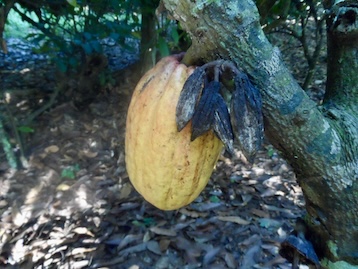
______
By Thomas d’Aquin Kouakou and ILISSOU Arounan
Thomas d’Aquin is Agribusiness Manager with CIFOR-ICRAF, and project manager of Scaling up Cocoa-based Food Systems, Land Use and Restoration/Transformative Innovations in Côte d'Ivoire (SCOLUR-CI). ILISSOU Arounan is Deputy Director of Projects and Financing Research with SODEFOR.
This week, in many parts of the world, lovers will exchange chocolates as romantic tokens of mutual affection to celebrate Valentine’s Day.
While some people think it is a commercialized gimmick, the annual February 14 ritual shines a spotlight on cocoa, one of the eight commodities included under the umbrella of the Food Systems, Land Use and Restoration (FOLUR) Impact Program.
Chocolate forms when cocoa beans – the fruit produced by the cacao tree (Theobroma cacao) – are ground into paste and powder, sweetened and used as chocolate in a range of readily accessible edible products. From beverages to syrups, toppings, milk, ice cream, cookies, cakes, and more, they sate the sweet tooth worldwide.
Cocoa is also widely recognized for its health benefits as an antioxidant and used in medicines.
Formerly, a somewhat exclusive treat, a combination of economic, social and cultural factors has made chocolate – often associated with luxury, conviviality and pleasure – accessible to a much larger consumer base.
The value of the global chocolate confectionery market was $87.5 billion in 2023, and projections indicate it will reach more than $146 billion by 2035.
Yet cocoa production faces many pressures, and recent dips in production and fears of further shortages have led to soaring and at times record-breaking prices.
Here in West Africa, unusually strong trade winds are parching cacao plantations raising the alarm that the world’s largest producer, Côte d’Ivoire – where we are based – will experience its fourth year of lower yields. The country shipped 36% less cocoa for export than it did last year.
Another factor contributing to lower yields are deforestation measures. These can limit land areas available for cocoa farming and restrict expansion. Local farming practices that involve forest clearing may need to be abandoned, requiring the adoption of new techniques which can lead to lower production during the period of adjustment.
Cocoa production puts vast pressure on Côte d’Ivoire’s ecosystems. Although there are some signs of slowdown, high rates of deforestation have led to significant biodiversity loss. Agricultural expansion for cocoa production, a major contributor to the loss of 90 percent of natural forests in less than a century, is compounding the challenges caused by the West African Trade Winds.
This is where FOLUR Côte d’Ivoire comes in – we are focusing our efforts on applied research, generating evidence-based solutions with the aim of attracting new investments in deforestation-free cocoa. These activities will help make a transition toward more sustainable cocoa production models.
Cocoa production is putting vast pressure on the country’s ecosystems, which overall supply about a third of cocoa worldwide, with high rates of deforestation accelerating leading to significant biodiversity loss.
The FOLUR Côte d’Ivoire project executed by the Food and Agriculture Organization of the United Nations (FAO) and implemented by the United Nations Development Programme (UNDP) and the United Nations Industrial Development Organization (UNIDO) focuses on applied research, generating evidence-based solutions and attracting new investments in deforestation-free cocoa. The project is facilitating a transition toward more sustainable cocoa production models.
The project is nearing the end of its first year of activity across three landscapes in Cavally, Indenié-Djuablin and La Mé (also known as Massan) regions.
A multistakeholder platform designed to tackle the challenge of cocoa-related deforestation in the regions is showing results. Estimates indicate that at least 50,000 hectares are landscapes are now under improved practices.
The Center for International Forestry Research and World Agroforestry (CIFOR-ICRAF) research center has targeted 20,000 ha for restoration in total.
Efforts to restore 2,700 hectares of cocoa plots are underway in partnership with the National Agency for Rural Development (ANADER), and market regulator Conseil Café Cacao, as part of their contribution to reforestation of cocoa and coffee farms.
Forest management agency SODEFOR targeted 1,500 ha for restoration by the end of 2024, and forecasts are 1,250 ha of reforestation for 2025, including integration of food crops and forest plants, the protection of community forests, sacred sites and private forests.
In addition to the efforts of FOLUR and other technical and financial partners, it will be necessary to integrate the Côte d’Ivoire government policy on Nationally Determined Contributions (NDCs) with respect to Agriculture, Forestry and Other Land Use (AFOLU) or an agroforestry policy as part of the strategy to reclaim forest cover.
These efforts will lead to a more sustainable value chain, continuing to provide the many benefits cocoa and chocolate have to offer, including smoothing the way for romance on Valentine’s Day.
The Food Systems, Land Use and Restoration Impact Program (FOLUR) is a $345 million, seven-year initiative funded by the Global Environment Facility and led by the World Bank. Seeking to transform food and land use systems, the program consists of a global knowledge platform and 27 country projects. Country-level work focuses on accelerating action in landscapes and along value chains for eight major commodities, including livestock, cocoa, coffee, maize, palm oil, rice, soy and wheat.
[Published, Feb. 13, 2025]







